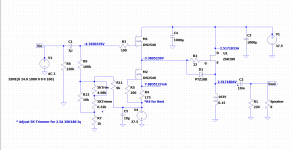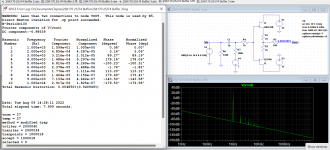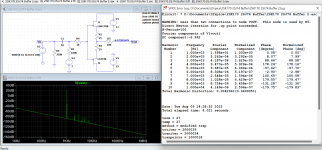Ben, I have this running since june last year now. (& I have the standard 2SK170/2SJ74 pair of a buffer).
One additional trick: I have the Vb adjustable, and have it such that the Vb+ plus the bias is equal to the Vb-. So: 12V - 3.3 = 3.3 + Vb+; VB+= around 9 volts.
I my implementation with 2SK182 I have Vb- to start off as -25V, my Vbias= -6 or -7 volt, the bottom jFet sees 18 volts; and so my Vb+ is 11 volt so the top again sees 18 volts. I tried it lopsided with straight +/- 25 V but I found (imagined like everything is here) that it introduced some less sounding effects (less warmth).
One additional trick: I have the Vb adjustable, and have it such that the Vb+ plus the bias is equal to the Vb-. So: 12V - 3.3 = 3.3 + Vb+; VB+= around 9 volts.
I my implementation with 2SK182 I have Vb- to start off as -25V, my Vbias= -6 or -7 volt, the bottom jFet sees 18 volts; and so my Vb+ is 11 volt so the top again sees 18 volts. I tried it lopsided with straight +/- 25 V but I found (imagined like everything is here) that it introduced some less sounding effects (less warmth).
Hi Al,
Doing a push-pull buffer increases the voltage limits of the signal so that is good for a follower output stage.
I think I understand what you did. Here is my LTSpice interpretation of the concept of your buffer.
The simulation did show though that the equal V+ and V- to the JFETs (unequal Vds) produced the higher distortion as I would have expected.
But the unbalanced V+ and V- (equal Vds) does equalize the dissipation in the JFETs which is a good thing as the SK170's dissipation would otherwise be quite high.
Doing a push-pull buffer increases the voltage limits of the signal so that is good for a follower output stage.
I think I understand what you did. Here is my LTSpice interpretation of the concept of your buffer.
The simulation did show though that the equal V+ and V- to the JFETs (unequal Vds) produced the higher distortion as I would have expected.
But the unbalanced V+ and V- (equal Vds) does equalize the dissipation in the JFETs which is a good thing as the SK170's dissipation would otherwise be quite high.
Attachments
common drain ..... well, I'm not so sure there is strong enough technical reason** to use them that way - you can practically get everything the same (or even better) using damn IXYS puck
Once i built for giggles a follower using an IXYS puck. Sounded nothing like a SIT. While the measured damping factor was more than twice higher, even the bass sounded worse than the SIT.
ZM may not agree with us, but we are in good company. Papa Pass is on our side. He chose common drain for the diyAudio single ended VFET amps. 🙂
considering that being smarter than Pa newer was an option, what else is left, than insisting to doing it differently?


SIT1 is a common source amp. 🙂He chose common drain for the diyAudio single ended VFET amps. 🙂
To me, the benefit of common source amp is it does not always require gain stage. Many years ago, when I was experimenting the original L'amp with Sony SIT, I compared different configurations including choke loaded, CCS and resistor loaded. I ended up liking a choke loaded version with self bias. It is a version with least amount of active device, only 1. Since then, maybe I'm just stupid, but I decided to pursue an amp with minimal amount of active device like Pass's SIT-1.
My current last SIT amp was common drain, but it still had only 2 active devices, high voltage 2SJ28 as a gain stage (Luminaria), and 182ES as a follower, both self biased. It measured good and sounded good to me. BTW, it seems triode connected pentode like EL803S as a gain stage works pretty well on LTSpice, but I have never tested it myself.
Anyway, enjoy searching your dream SIT amp. We have a lot of opportunities with SIT!
While the measured damping factor was more than twice higher
Fwiw, the measured distortion was also double that of the SIT follower.
Is it possible the SIT/follower preference is due to inability to cope with high distortion? I remember what the BAF2015 sounded like and these are not pleasant memories.
I started with common source single ended SIT and ended with common drain (follower) single ended SIT. As I listened, I gradually started to prefer lower levels of distortion. It's still predominantly second harmonic but at lower levels. The single ended SIT followers provided that. In my system the SIT followers have a sense of clarity and realism that the common source single ended SIT amps did not have. So there seems to be some correlation there.
I am not saying that common source SIT amps sound bad, it's just that I have found that common drain SIT amps sound better.
It's all about the sound. 🙂
I am not saying that common source SIT amps sound bad, it's just that I have found that common drain SIT amps sound better.
It's all about the sound. 🙂
The size of choke definitely affects both distortion level and low frequency extension. With common drain versions, it is much easier to control low freq behavior just swapping the chokes. In other words, we can build a high distortion version of follower amp just using a small choke. 🙂
I started with common source single ended SIT and ended with common drain (follower) single ended SIT. As I listened, I gradually started to prefer lower levels of distortion. It's still predominantly second harmonic but at lower levels. The single ended SIT followers provided that. In my system the SIT followers have a sense of clarity and realism that the common source single ended SIT amps did not have. So there seems to be some correlation there.
I am not saying that common source SIT amps sound bad, it's just that I have found that common drain SIT amps sound better.
It's all about the sound. 🙂
well, that's officially cheating!
now we started listening the amps!?!


Being that confusion is my natural state - I see that you have placed the choke on the drain and ra7 has it in the source - obviously it works well in either place and I may be assuming too much that placing it in the drain allows a smaller choke?
Can think of no one better to give a concise explanation of why would use one or the other or does it simply not make any difference?
Thanks,
Can think of no one better to give a concise explanation of why would use one or the other or does it simply not make any difference?
Thanks,
Not Ben but I’ll offer some thoughts. If you pull the output from the drain, you get voltage gain AND current gain. Usually an order of magnitude more distortion than if you take it from the source.
If you take the output from the source, it provides only current gain, useful to drive the loudspeaker. Voltage gain must come from somewhere else, usually the preamp. But the benefit is that you get much lower distortion.
I tried it with the choke on the drain. The signature is like that of a good 300B amp. In my system, it sounds too thick for my liking and doesn’t let all the details come through. It sounds so much better operated as a source follower. I recall Ben prefers it this way too.
If you take the output from the source, it provides only current gain, useful to drive the loudspeaker. Voltage gain must come from somewhere else, usually the preamp. But the benefit is that you get much lower distortion.
I tried it with the choke on the drain. The signature is like that of a good 300B amp. In my system, it sounds too thick for my liking and doesn’t let all the details come through. It sounds so much better operated as a source follower. I recall Ben prefers it this way too.
Basically what ra7 said.
It started out common source with the choke on the drain side and the output on the drain side for voltage gain. This is similar to single ended triode tube amplifiers. I enjoyed the sound for a while but I had one problematic 2SK180 that had high gate leakage current. After much messing around trying to tame it, I decided to change the amplifier to common drain and place the choke at the source, and taking the output from the source for follower operation.
Change to source follower: Common Drain - post #109
That helped to control the runaway tendency, and the big win was that I much preferred the sound.
I could have added resistance at the source to further control the gate leakage current but in the end I replaced the problematic 2SK180 with a well behaving one.
But the source follower implementation stayed.
I liked it so much that I converted my choke loaded 2SJ28 single ended amp and my THF-51S Mu Follower amp to common drain follower amps:
My 2SJ28 Choke Loaded Follower
My THF-51S Mu-Follower Follower
It started out common source with the choke on the drain side and the output on the drain side for voltage gain. This is similar to single ended triode tube amplifiers. I enjoyed the sound for a while but I had one problematic 2SK180 that had high gate leakage current. After much messing around trying to tame it, I decided to change the amplifier to common drain and place the choke at the source, and taking the output from the source for follower operation.
Change to source follower: Common Drain - post #109
That helped to control the runaway tendency, and the big win was that I much preferred the sound.
I could have added resistance at the source to further control the gate leakage current but in the end I replaced the problematic 2SK180 with a well behaving one.
But the source follower implementation stayed.
I liked it so much that I converted my choke loaded 2SJ28 single ended amp and my THF-51S Mu Follower amp to common drain follower amps:
My 2SJ28 Choke Loaded Follower
My THF-51S Mu-Follower Follower
Last edited:
My thanks to you both.
More evidence of my unintended goofiness - I was looking at the wrong schematic on Ben Mah's thread.
Waiting for ra7s pcbs to become available and then to give this a try.
I will be converting my SINGING BUSHes - so I am using THF51s.
Thanks for the time and clarification.
I have asked Dave Slagle about making chokes for this amplifier. He says he will make them but I have yet to hear back from him.
In the interim i will use the LL2733s I used in my SIT 1 power supplies to convert two of my amplifiers in anticipation of Dave coming up with something.
He asked if I needed a plate choke or a power supply choke and I told him I guess it needs to be a bit of both.
I initially said 150 mH and 3 amps but wonder if it would not be a good idea to up that to 4 amps? Any comment about that?
I figure with wire sufficient for the current if the windings make that much difference? I would not think you could do much fancy winding with thick wire? Any advice here for me to relay to Dave?
Thanks, again,
More evidence of my unintended goofiness - I was looking at the wrong schematic on Ben Mah's thread.
Waiting for ra7s pcbs to become available and then to give this a try.
I will be converting my SINGING BUSHes - so I am using THF51s.
Thanks for the time and clarification.
I have asked Dave Slagle about making chokes for this amplifier. He says he will make them but I have yet to hear back from him.
In the interim i will use the LL2733s I used in my SIT 1 power supplies to convert two of my amplifiers in anticipation of Dave coming up with something.
He asked if I needed a plate choke or a power supply choke and I told him I guess it needs to be a bit of both.
I initially said 150 mH and 3 amps but wonder if it would not be a good idea to up that to 4 amps? Any comment about that?
I figure with wire sufficient for the current if the windings make that much difference? I would not think you could do much fancy winding with thick wire? Any advice here for me to relay to Dave?
Thanks, again,
I used a Hammond 193V which is 150mH at 3A because that was specified by Michael Rothacher for the choke loaded VFET L'Amp that I had previously built. It worked out for my 2SK180 amp as the frequency response and distortion levels were good, and there were no issues with the sound.
But I am no expert. Dave is, so you should tell Dave what your plans are for the choke and ask him for his recommendations.
But I am no expert. Dave is, so you should tell Dave what your plans are for the choke and ask him for his recommendations.
Hey Rick, I had custom 200mH/10A (MASSIVE) chokes made last year in anticipation of Ben/ZM's creations. Don't think you need 10A though, I have a link, on the road now....I'll dig it up for you. It's currently in use in a BAF2015 circuit with the Mu replaced with the big choke, pic are around somewhere.
John
John
I will need four chokes.
Your choke sounds like the proper thing for the CHOKED SINGING BUSH.
My guess is that your chokes resistance might be TOO low for these amps? I certainly do not know for sure.
I hope what Dave recommends are not too massive!
Your choke sounds like the proper thing for the CHOKED SINGING BUSH.
My guess is that your chokes resistance might be TOO low for these amps? I certainly do not know for sure.
I hope what Dave recommends are not too massive!
Its my understanding that the lower the resistance the better, either for common source or a follower, but I could be wrong. Anywho, here's the link, https://www.ecraftsmen.com/. They were definitely pricey. You could probabaly get away with a 100mH/5A like the Hammond 195T5; available at Mouser and reasonably priced. It seems theres no free lunch if you want some extra current and lots of mH.
John
John
- Home
- Amplifiers
- Pass Labs
- 25W Single Ended Hammond 193V Choke Loaded 2SK180 L'Amp


